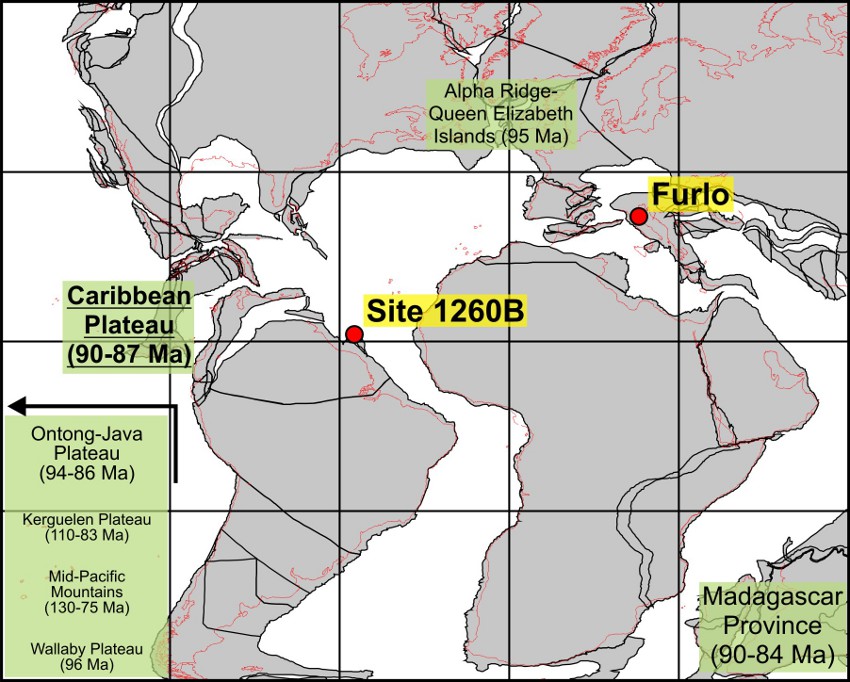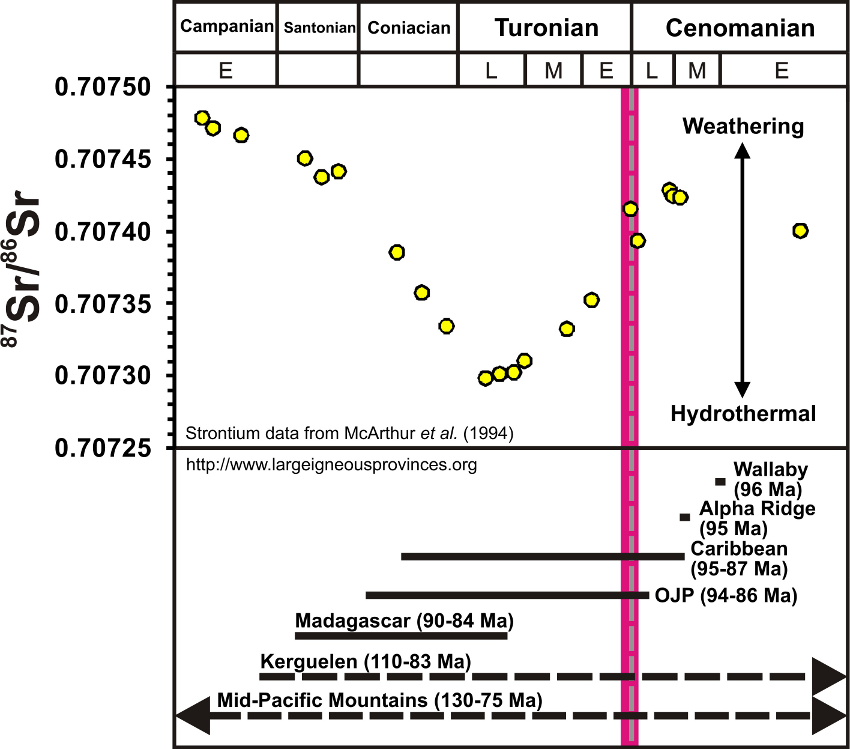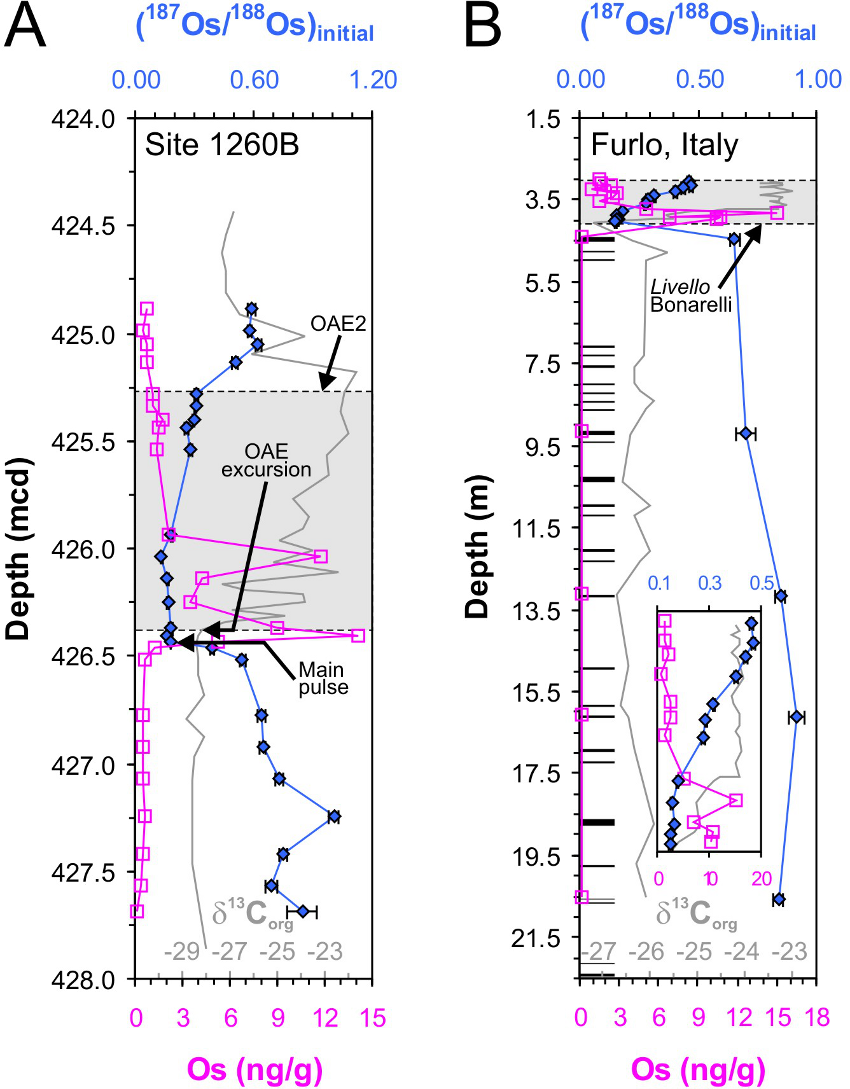September 2011 LIP(s) of the Month
The osmium record of a Late Cretaceous LIP emplacement at the Cenomanian-Turonian boundary
Steven Turgeon
Dept. of Earth Sciences, Carleton University
Ottawa, Ontario K1S 5B6, CANADA
E-mail: scturgeo@earthsci.carleton.ca
Rob Creaser
Dept. of Earth & Atmospheric Sciences, University of Alberta
Edmonton, Alberta T2G 2E3, CANADA
Daniele Tiraboschi and Elisabetta Erba
Dipartimento di Scienze della Terra Ardito Desio, Università di Milano
20133 Milan, ITALY
The Oceanic Anoxic Event 2 (OAE2; 93.5 Ma) was a geologically short event (ca. <500 kyrs) at the Cenomanian-Turonian boundary of the Late Cretaceous. This event was characterised by widespread deposition of marine organic carbon-rich sediments under oxygen deficient conditions, as recorded by similar δ13C isotopic ratios records at several distant sites [1]. This carbon sequestration event also coincided with a selective - albeit severe - marine extinction, as well as appears to have led to an ephemeral but significant reduction [2] in the partial pressure of atmospheric CO2 and cooling of surface temperatures [3,4] owing to feedback mechanisms.
While the enhanced burial of organic matter can be explained either through increased primary productivity and/or enhanced preservation scenarios [5,6], the actual trigger mechanism, corresponding closely with the onset of OAE2 carbon sequestration, has proven elusive. It has been postulated that large-scale magmatic activity such as the emplacement of a large igneous province (LIP) or heightened activity at mid-ocean ridges initially triggered OAE2 [7,8]. Should this be the case, then a major magmatic episode must be coeval with, or immediately precede, the carbon isotope excursion. However, the linking of magmatism to OAE initiation has relied either on indirect evidence provided by the coincidence of LIP emplacement (which is a particular problem for OAE2 as several candidates such as the Caribbean-Colombian Igneous Province, Kerguelen and Ontong Java plateaus, or the Madagascar flood basalts have likely erupted close to this time period; Figs. 1 & 2) along with 87Sr/86Sr isotopes in the sedimentary record which document the interplay of weathering and mantle-derived strontium input to the oceans [9-12] (Fig. 2). In total, ca. 20×106 km3 of intraoceanic, plume-related basalts erupted near the Cenomanian-Turonian boundary [13], and it has been suggested that the lead isotope ratios show a shift in isotopic ratios near the base of OAE2 toward values of Caribbean-Colombian Igneous Plateau and Madagascar flood basalts [14]. However, although the Sr isotope record of carbonate sediments close to the Cenomanian-Turonian boundary trends towards less radiogenic values indicative of a relative increase of magmatic and hydrothermal input of Sr to the oceans [12], the long residence times of Sr in oceans (ca. 3 Myrs) does not allow precise correlation of magmatism to the onset of OAE2.

Figure 1: Approximate locations of large igneous provinces (in green; from www.largeigneousprovinces.org) emplaced approximately at the Cenomanian-Turonian boundary. Also shown are the two study sites (in yellow): Demerara Rise adjacent to the east-northeast coast of South America (Ocean Drilling Project Site 1260B), located in the southern proto-North Atlantic during the Cenomanian-Turonian, as well as from the Furlo section in central Italy, formerly located in the western Tethys Seaway. These two sites were ca. 5500 km apart during OAE2. Base map shows plate reconstruction at 93.5 Ma (from www.odsn.de/odsn/services/paleomap/paleomap.html).

Figure 2: Strontium isotope of carbonates sediments (from ref. 12) for the Upper Cretaceous surrounding the Cenomanian-Turonian boundary (vertical dashed line). Ages have been recalculated following the timescale of the International Committee on Stratigraphy. The large igneous province age ranges are from www.largeigneousprovinces.org. The approximate duration of OAE2 is shaded pink.
Similarly to strontium, dissolved osmium in modern seawater (187Os/188Os = 1.06) [15] reflects mass balance between Os input from hydrothermal alteration of juvenile oceanic crust (187Os/188Os = 0.127), average riverine input from continental weathering (187Os/188Os = 1.4), together with a generally minor extraterrestrial contribution from meteorites and cosmic dust particles (187Os/188Os = 0.127) to the global ocean [16]. The short oceanic residence time of Os (~10,000 years) allows short-term (kyrs) fluctuations in seawater isotopic composition to be precisely recorded in sediments, as most of the osmium in black shales is derived from seawater, the 187Os/188Os ratios of black shales are typically representative of contemporaneous seawater [15].
In an 2008 Nature article, Turgeon and Creaser [17] reported seawater 187Os/188Os isotope ratios in organic-rich sediments from two sites located ca. 5500 km apart from each other during the Cenomanian (Fig. 1; ODP Site 1260B from Demerara Rise, and from the Furlo section in Italy). At both study sites, the marine 187Os/188Os record changes abruptly just at, or prior to, the δ13Corg excursion of ~3‰ [4,18] defining the OAE2 onset (Fig. 3). At Site 1260B, Os isotope values decrease irregularly from 0.69-1.0 to 0.54 prior to OAE2, and drop to 0.17 a few cm before the OAE. At Furlo, Os isotope values in the “black levels” beneath the main organic-rich unit (termed the Livello Bonarelli) show a slight decline upwards (from 0.92 to 0.66), suggesting that the relative fluxes of the major Os inputs to oceans have remained somewhat steady prior to OAE2 onset, perhaps over timescales of 106 yrs [19]. An abrupt decrease in marine 187Os/188Os from 0.66 to 0.16 occurs between the uppermost black level and the base (comprising approximately the lower 1/3) of the Bonarelli. Prior to OAE2, Os contents are low (<1 ng/g) but increase abruptly just before the OAE at Site 1260B and close to the base of the Furlo to values exceeding 14 ng/g. In addition, an apparent double spike of Os enrichment occurs at both sites in the interval of low 187Os/188Os ratios (Fig. 3). The similar structure and magnitude of Os records (contents and isotopic ratios) at both sites strongly suggest that these signals are primary in nature, and that the same process(es) were operating at both sites.

Figure 3: Initial seawater 187Os/188Os isotope ratios (blue), Os contents (red), and δ13Corg values (grey) for the two studied sites: a) ODP207 Site 1260B (n = 25); b) Furlo, Italy (n = 17). Extent of the OAE2 for Site 1260B is based on carbon isotope ratios. Horizontal black bars represent location of “black levels” beneath the Bonarelli at Furlo. Inset shows data points within the Livello Bonarelli. "Black levels" (translated from "niveaux noirs" in French) is the term used for the 29 or so organic-rich units beneath the Bonarelli (going down to approximately 20 m beneath). Error bars represent 2σ uncertainties of calculated initial seawater Os isotope ratios. δ13Corg values from ref. 4 for Site 1260B and from ref. 18 for Furlo. Figure from ref. 17.
Although the low 187Os/188Os values at the OAE might also result from an extraterrestrial source, such as impact of a large bolide [16], iridium profiles within the Bonarelli at Furlo [20] do not support this hypothesis, and typical impact-related features such as shocked quartz have not been reported from OAE2. The apparently prolonged input of mantle derived Os with a low 187Os/188Os ratio to the oceans is also consistent with existing data showing an increase in several trace elements, including zinc which is commonly associated with hydrothermal activity [19], at both Furlo and at Site 1260B [21]. The Os content records at both sites, in conjunction with a marine residence time of Os in the modern ocean of ca. 10 kyrs, indicate high, but variable input of Os to the oceans – probably from at least two major magmatic pulses – during the early phases of OAE2. The specific pathway(s) for transfer of unradiogenic Os from LIP magmatism to the oceans is poorly constrained, but conceivably involves the seafloor hydrothermal processes invoked for fluxes of other metals at OAE2 (e.g. ref. 7). However, the Os contents of both high- and low-temperature hydrothermal fluids from mid-ocean ridge settings are generally close to, or below, seawater concentrations [22]. This observation suggests that the release of unradiogenic Os during LIP emplacement – as indicated by the isotopic data – likely occurred at much higher flux rates and/or fluid concentrations than is typical of known mid-ocean ridge hydrothermal systems.
Using a simple two-component mixing equation assuming chondritic (0.127) and bulk continental (1.4) Os isotopic end-members [15], we can calculate that over 97% of the total Os content at both sites is magmatic in origin (compared to ~27% for present-day oceans). This represents a ca. 30-50 fold increase relative to pre-OAE conditions assuming a constant riverine input. Furthermore, the Os contents at the base of the OAE2 interval for both sites show enrichment factors of the same order of magnitude compared to pre-OAE2 conditions, suggesting that the increased Os contents mainly reflect a change in the seawater Os inventory. Osmium isotope data has also been used as a marker of magmatic activity onset just before the Triassic-Jurassic boundary in the Central Atlantic magmatic province [23] and the Cretaceous/Tertiary boundary in the Deccan Flood Basalts [24].
Osmium isotope measurements indicate that large-scale magmatic activity occurred close to the onset of black shale deposition, as indicated by the Os isotope ratios in organic-rich sediments. The calculated initial 187Os/188Os ratios reflecting contemporaneous seawater Os isotopic values drop abruptly from 0.7-1.2 to unradiogenic values of ~0.14-0.15 at OAE2 onset. These low values are most likely linked to magmatic activity as no evidence of bolide impact has been reported near this stage boundary. These results indicate that >97% of the Os in contemporaneous seawater is magmatic in origin, a ca. 30-50 fold increase relative to pre-OAE2 conditions.
1. Tsikos, H., et al. Carbon-isotope stratigraphy recorded by the Cenomanian–Turonian Oceanic Anoxic Event: correlation and implications based on three key localities. J. Geol. Soc. Lond. 161, 711–719 (2004).
2. Kuypers, M.M.M., Pancost, R.D. & Sinninghe Damsté, J.S. A large and abrupt fall in atmospheric CO2 concentration during Cretaceous times. Nature 399, 342–345 (1999).
3. Arthur, M.A., Dean, W.E. & Pratt, L.M. Geochemical and climatic effects of increased marine organic carbon burial at the Cenomanian/Turonian boundary. Nature 335, 714–717 (1988).
4. Forster, A., Schouten, S., Moriya, K., Wilson, P.A. & Sinninghe Damsté, J.S. Tropical warming and intermittent cooling during the Cenomanian/Turonian oceanic anoxic event 2: Sea surface temperature records from the equatorial Atlantic. Paleoceanography 22, doi:10.1029/2006PA001349 (2007).
5. Schlanger, S.O. & Jenkyns, H.C. Cretaceous anoxic events: causes and consequences. Geol. Mijnb. 55, 179–184 (1976).
6. Schlanger, S.O., Arthur, M.A., Jenkyns, H.C. & Scholle, P.A. The Cenomanian–Turonian Oceanic Anoxic Event, I. Stratigraphy and distribution of organic carbon-rich beds and the marine δ13C excursion. Geol. Soc. Lond. Spec. Publ. 26, 371–399 (1987).
7. Sinton, C.W. & Duncan, R.A. Potential links between ocean plateau volcanism and global ocean anoxia at the Cenomanian–Turonian boundary. Econ. Geol. 92, 836–842 (1997).
8. Kerr, A.C. Oceanic plateau formation: a cause of mass extinction and black shale deposition around the Cenomanian–Turonian boundary. J. Geol. Soc. Lond. 155, 619–626 (1998).
9. Snow, L.J., Duncan, R.A. & Bralower, T.J. Trace element abundances in the Rock Canyon Anticline, Pueblo, Colorado, marine sedimentary section and their relationship to Caribbean plateau construction and oxygen anoxic event 2. Paleoceanography 20, doi:10.1029/2004PA001093 (2005).
10. Storey, M., et al. Timing of hot-spot related volcanism and the breakup of Madagascar and India. Science 267, 852–855 (1995).
11. T.H. Torsvik, et al. Late Cretaceous magmatism in Madagascar: palaeomagnetic evidence for a stationary Marion hotspot. Earth Planet. Sci. Lett. 164, 221–232 (1998).
12. McArthur, J.M., Kennedy, W.J., Chen, M., Thirlwall, M.F. & Gale, A.S. Strontium isotope stratigraphy for Late Cretaceous time: Direct numerical calibration of the Sr isotope curve based on the US Western Interior. Palaeogeogr. Palaeoclimatol. Palaeoecol. 108, 95–119 (1994).
13. Wignall, P.B. Large igneous provinces and mass extinctions. Earth Sci. Rev. 53, 1–33 (2001).
14. Kuroda, J., et al. Contemporaneous massive subaerial volcanism and late cretaceous [sic] Oceanic Anoxic Event 2. Earth Planet. Sci. Lett. 256, 211–223 (2007).
15. Peucker-Ehrenbrink, B. & Ravizza, G. The marine osmium isotope record. Terra Nova 12, 205–219 (2000).
16. Pegram, W.J. & Turekian, K.K., The osmium isotopic composition change of Cenozoic sea water as inferred from a deep-sea core corrected for meteoritic contributions. Geochim. Cosmochim. Acta 63, 4053–4058 (1999).
17. Turgeon, S.C. & Creaser, R.A. Cretaceous oceanic anoxic event 2 triggered by a massive magmatic episode. Nature 454, 323-326 (2008).
18. Jenkyns, H.C., Matthews, A., Tsikos, H. & Erel, Y. Nitrate reduction, sulfate reduction, and sedimentary iron isotope evolution during the Cenomanian-Turonian oceanic anoxic event. Paleoceanography 22, doi:10.1029/2006PA001355 (2007).
19. Turgeon, S. & Brumsack, H.-J. Anoxic vs dysoxic events reflected in sediment geochemistry during the Cenomanian–Turonian Boundary Event (Cretaceous) in the Umbria–Marche Basin of central Italy. Chem. Geol. 234, 321–339 (2006).
20. Alvarez, W., Alvarez, L.W., Asaro, F. & Michel, H.V. The End of the Cretaceous: Sharp Boundary or Gradual Transition? Science 223, 1183–1186 (1984).
21. Turgeon, S.C., Hetzel, A., Tiraboschi, D., Creaser, R.A., Brumsack, H.-J. & Erba, E. Contrasting osmium isotopes and Zn/Al ratios as magmatism proxies in Cenomanian-Turonian sediments. Geochimica et Cosmochimica Acta 73, Issue 13, Supplement 1, 53 (2009).
22. Sharma, M., Rosenberg, E.J., & Butterfield, D.A. Search for the proverbial mantle osmium sources to the oceans: Hydrothermal alteration of mid-ocean ridge basalt. Geochim. Cosmochim. Acta 71, 4655–4667 (2007).
23. Cohen, A.S. & Coe, A.L. New geochemical evidence for the onset of volcanism in the Central Atlantic magmatic province and environmental change at the Triassic-Jurassic boundary. Geology 30, 267–270 (2002).
24. Ravizza, G. & Peucker-Ehrenbrink, B. Chemostratigraphic Evidence of Deccan Volcanism from the Marine Osmium Isotope Record. Science 302, 1392–1395 (2003).